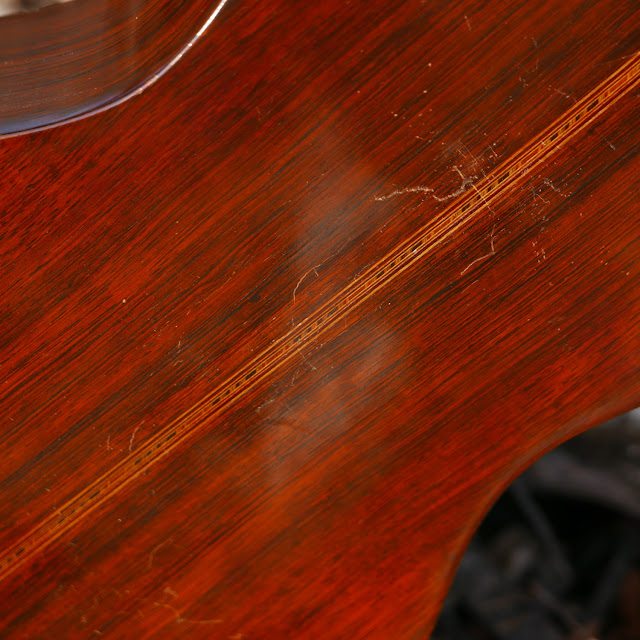1890s Joseph Bohmann Parlor Guitar
A customer of mine has had me really going at-it with a brace of Bohmann guitars, but this one is a trade-in from him for repairs on another. It's closest in size/shape/build to the 1900 Paris Expo Bohmann, and sounds reasonably-the-same, too. While its trim is pretty spare (save some cute pearl in the board and an understated rosette), the materials are luxurious -- Brazilian rosewood back/sides, a tight-grain, quadruple-x-braced top, and mahogany neck. It sounds as good as that rosewood looks, too, with a full-but-compact voice that's hard to describe. It's a bit like playing a high-brow modern parlor but with more of that 1920s Martin gut-strung x-braced velvety mwah under the hood.
It's also the one that's required the most work of the Bohmann bunch. For this one I had to plane the maple fretboard and refret the neck (tricky due to ebonized maple's tendency to dry and chip-out like mad), cobble some tuners together to fit the void of the original recessed tuner-plate design at the headstock, modify the original bridge to better-suit its new life, and whatever else I can't remember that I did on it.
After all the work, however, it plays perfectly with 3/32" action (hair-under that on the treble side) at the 12th fret and it's strung with a Thomastik-made PJ116 hybrid classical guitar set that features nylon-core basses and rope steel-core trebles (though the high E is a plain 9-gauge steel string right now) for classical tension but a more steel sound. I find it suits the x-braced tonality of these Bohmanns really well and gives the ability to fingerpick in a pleasingly classical-ish/folksy fashion or flatpick for a more old-timey tone.
It's also the one that's required the most work of the Bohmann bunch. For this one I had to plane the maple fretboard and refret the neck (tricky due to ebonized maple's tendency to dry and chip-out like mad), cobble some tuners together to fit the void of the original recessed tuner-plate design at the headstock, modify the original bridge to better-suit its new life, and whatever else I can't remember that I did on it.
After all the work, however, it plays perfectly with 3/32" action (hair-under that on the treble side) at the 12th fret and it's strung with a Thomastik-made PJ116 hybrid classical guitar set that features nylon-core basses and rope steel-core trebles (though the high E is a plain 9-gauge steel string right now) for classical tension but a more steel sound. I find it suits the x-braced tonality of these Bohmanns really well and gives the ability to fingerpick in a pleasingly classical-ish/folksy fashion or flatpick for a more old-timey tone.
Mr. Bohmann was certainly not shy about stains. This has a "pumpkin orange" top. Check out all the playwear!
This guitar is 12" on the lower bout and has 3 1/2" depth at the endpin. There are no cracks as far as I can tell -- save a couple dryness hairlines in the fretboard that're sealed-up and stable.
Like on other Bohmanns, the tuner ferrules are pearl "donut" rings. The original 1 11/16" nut is bone.
The folksy pearl inlay is delightful on Bohmann instruments. When I refretted, I used jumbo stock to help stiffen the neck via the larger tangs. It's working -- at tension the neck is dead straight despite the fact that it has a modern, slim, round-C shape to its rear.
Because the end of the fretboard would've chipped-off if I pressed a new fret into it, I omitted the very last fret during my refretting job.
Don't you love that multicolored rosette?
This bridge was originally rear-loaded with screws to set down-pressure where the bridge pins are now. I had to shave it a bit and so I drilled-out the screw-holes a a bit larger and set this up pin-bridge style with a set of new ebony pins. The saddle is a fret-saddle like the original but I used a new fret that had a rounder top to it than the old one (for less string-wear). There's a very thin, 1mm-depth hairline crack along the middle of the pinholes, but I've filled it and it hasn't been an issue since stringing-up (early last week).
It's the original bridge and is made from maple that's been ebonized black.
While there are numerous light scratches, the original finish positively glows on the rosewood back and sides.
This originally had recessed, mounted-on-one-backplate tuners. Since they were no longer on this guitar, I cobbled a set from some cut-up 1910s-era ones to fit. I used some rosewood bits to fill part of the void left by the original tuners and then cut-up a 1950s Kay acoustic tortoise-plastic pickguard to serve as a new backplate and mounting mechanism.
They look a little funky but at least look like an "old work-around" and have that vintage charm to them. They work well, too!
Did I mention that the rosewood just gushes loveliness?
There was a tiny, tapped hole where an endpin should be and so I filled that with a strap button -- though a normal endpin would be easily-fit, too.






















Comments